 |
Here are the various focal plane cameras in my collection. Note that SLR cameras, most have which have focal plane shutter, have their own page.
Other groups that can be found on other pages:
TLR cameras
folding
Most cameras on this site had leaf shutters, like the various Compurs and Prontors, which were usually mounted between the lens elements or, in case of interchangeable lens mounts, just behind the lens. As the name indicates, leaf shutters are build of 2 or more leafs, which rotate away and back when the shutter fires.
Another type of shutter was the focal plane shutter, usually mounted just in front of the film plane. It consisted of a moving piece of cloth, commonly called the curtain, with a gap that allowed light to reach the film. The shutter speed increases with the width of the gap, or, in case of longer shutter speeds, the time difference between the opening and closing curtains.
The advantage of the focal plane shutter was that it was relatively easy to reach higher shutter speeds like 1/1000 second. The drawback is that with speeds faster than ca. 1/30 s, the film is not exposed as a whole, so fast-moving objects can cause problems. Also, flash sync speeds were slow.
The most famous member of the focal plane shutter cameras is undoubtedly the Leica, plus all its various copies. Other ones are the Exakta range, the Finetta 99, the Foth Derby and the Contax/Kiev range. Examples of the Exakta, Contax and Finetta are detailed elsewhere on this site.
Leica I - IIIf
Many books have been written about the Leitz company and its cameras and lenses, and there is little point in repeating much here. Leitz invented the 35mm camera (Leica A) in the 1920s as a small and convenient alternative to the larger box, folding and TLR rollfilm cameras that were the standard cameras at the time. The Leica I caused quite a stir and other camera companies scrambled to catch up. Soon after Leitz developed the interchangeable lens mount, which allowed the use of different lenses as well as various accessories for macrophotography, copying etc., but required very high standards of manufacturing. Again, other companies scrambled to catch up. The increasing popularity of the new 35mm format led Kodak to invent the 135 film cartridge, which quickly became the dominant film format for the next 70 years or so, and in turn undoubtedly helped the popularity of the Leicas also.
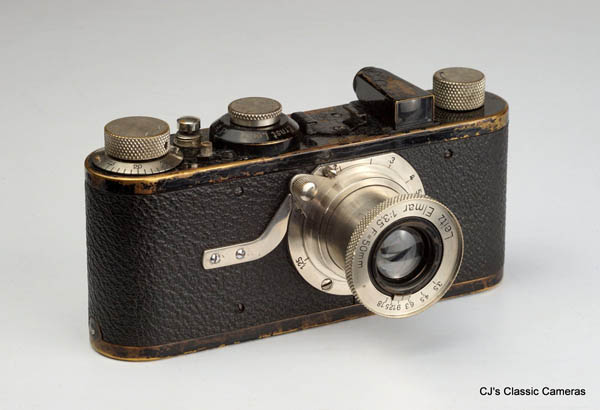
A 1929 Leica I model A with fixed (non-interchangable) but collapsible, uncoated Leitz Elmar 50mm f/3.5 lens. This model laid the foundation for all screw-mount Leicas that followed later, which had additional features such as rangefinders, slow shutter speeds, rangefinders and flash syncs, but had nearly identical layouts of the main camera controls.
It's hard to overstate the significance of the Leica I and how much easier it made photography. Most cameras at the time used rollfilm and one had to advance the film whilst peering through a red window at the back of the camera. Then one had to manually cock the shutter, and after taking your shot you'd have to stick to a routine of either advancing the film right away, or waiting until the next exposure, to avoid double exposures or blank frames. The Leica basically did all this with a single turn of the wind knob, and accidental double exposures or blank frames were impossible. It took about 10 years before other brands produced cameras with a similar level of sophistication and convenience, as well as reliability. In addition the camera was light and small enough to fit in most pockets or a small bag. No wonder it caught on quickly amongst professionals and (wealthy) amateurs alike.
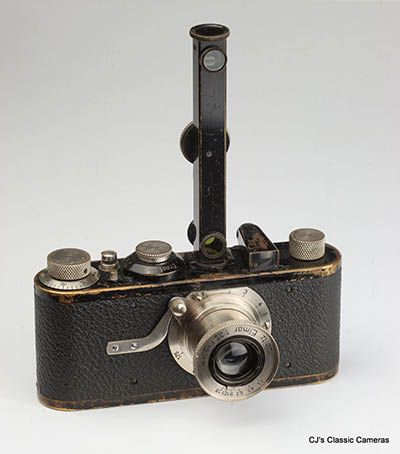
| |
Leica I with external FODIS rangefinder mounted. Leitz coded all their products with five-letter capitals, including the many accessories they produced. The FODIS was a long-base rangefinder mounted vertically, followed later by the FOFER with larger and thus more precise focus dial (for use with faster lenses such as the f/2 Summar), and later yet by the HFOOK which could be mounted horizontally but had a shorter base, more akin the build-in rangefinder on the Leica II.
|
Leicas have always been expensive, top-of-the-range cameras and are even more so these days, as Leitz seems to focus more on exclusive collector's items than cameras that are meant to be used (although they have re-introduced the Leica M6 as of late 2022!). Prices have more to do with collectability than anything else and are much inflated over what they used to cost compared to other cameras at the time. From that perspective Leicas are an excellent investment, but expect to pay through the nose for the simplest accessories!
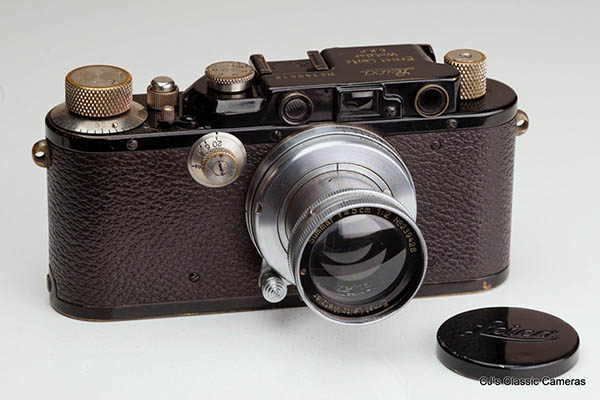
A black 1934 Leica III with uncoated Leitz Summar 50mm f/2 collapsible and interchangeable lens. The lens was made very early in 1935 so may well be the original lens sold with the camera, but its chrome plating doesn't go very well with the nickel plated knobs of the camera body. Nickel-plated Summars do exist, but are more rare.
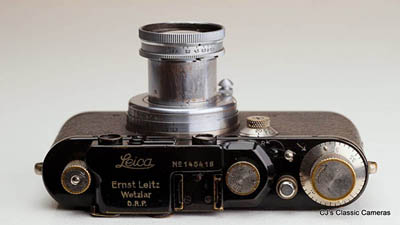
| |
Top view of the same black Leica III. What I like about the Leicas is how thin the bodies are. Once the lens is retracted they easily fit into your coat pocket.
|
The Leica III series was introduced in 1933 and featured a 39mm screw mount (a.k.a. LTM or L39 mount), a rangefinder with 1.5x magnification and separate viewfinder plus a slow speed dial at the front of the camera in addition to the regular speed dial on top. The Leica II series lack the slow speed option, whereas the Leica I series had no rangefinder. For all lenses other than the standard one one would need separate viewfinders.
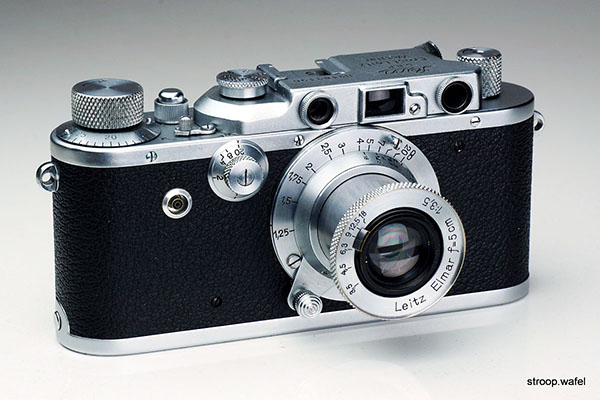
A 1935 Leica IIIa (ser. 183196) with uncoated Leitz Elmar 50mm f/3.5 collapsible lens. The flash sync must have been a later addition but has been very professionally done. There is no flash synchroniser dial like on the later Leica IIIf, so I suspect the flash only synchronises at very slow speeds of about 1/20s in which case the shutter curtains are far enough apart to expose to whole film at once. This was a drawback of focal plane shutters compared to leaf shutters, which would sync at all speeds.
The Leica IIIc was the first with a diecast body, which made the body more rigid, and had an integrated top housing with rangefinder cover as well as better shielding around the film gate which reduced fogging of film left in the camera for longer periods of time. Another change was the rangefinder magnifier, which was moved from behind the eye piece to beneath the rewind knob. Furthermore the 1/30s speed moved to the slow speed dial.
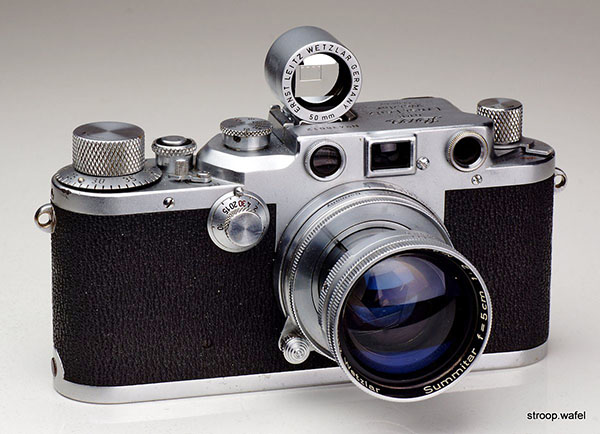
A 1947 Leica IIIc with Leitz Summitar 50mm f/2 lens. A somewhat disappointing aspect of using screwmount Leicas up till the IIIg was the underwhelming viewfinder. However, Leica did, however, produce a separate 50mm viewfinder, named SBOOI, and this is simply the best viewfinder I have ever used. Its view exactly 1:1 so one can keep both eyes open whilst looking through the viewfinder and see a frame projected in your field of vision. It works in near darkness and is exceptionally clear. These are not cheap but definitively worth it. The one pictured here is a later version (ca. 1958) with markings in capitals letters and focal length in mm.
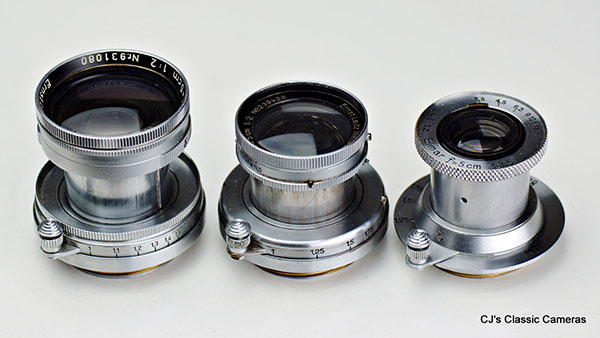
Three different standard lenses were available in Leica screw mount, from left to right the f/2 Summitar, the f/2 Summar and the f3.5 Elmar (later updated to f/2.8), ignoring the f/2 Summicron which was introduced near the end of the screwmount era. Although the Elmar f/3.5 is an excellent lens, I prefer the larger aperture of the Summitar and the associated shallower depth-of-field. It is also an extremely sharp lens, it being a seven-element lens with large front element, at smaller apertures easily outresolving the 24 MP APS-C sized sensor on my DSLR camera. That said, I find the Summar the best looking lens of the three, preferring its rounded base and smaller front element over the Summitar on screwmount Leicas.
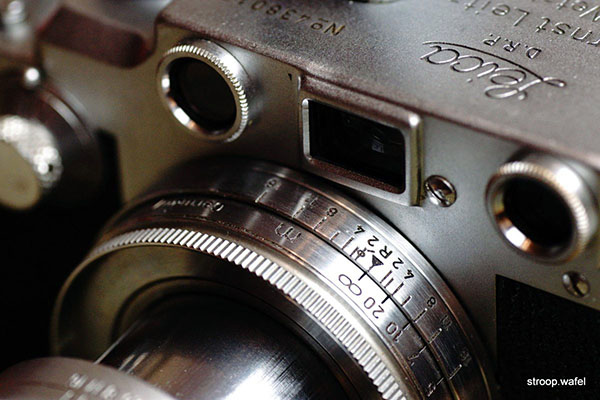
Detail of the Leica rangefinder windows and Summitar lens base taken with the Elmar mounted on a Sony A77 DSLR. As the register distance of the Sony is much larger than that of the Leica screw mount, the Leitz lenses make great macro lenses. As they can be partially collapsed the maximum focus distance is about 4 ft.
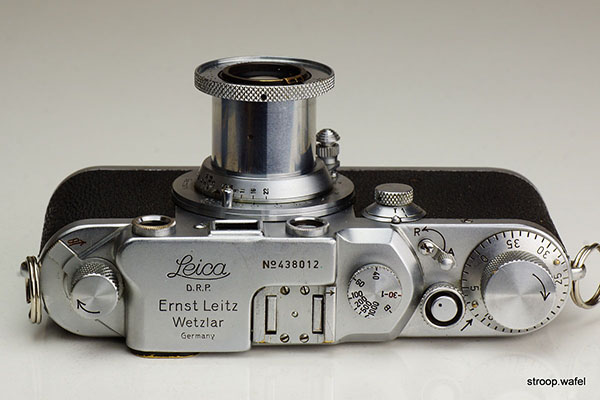
Top view of a Leica IIIc with the collapsible lens extended.
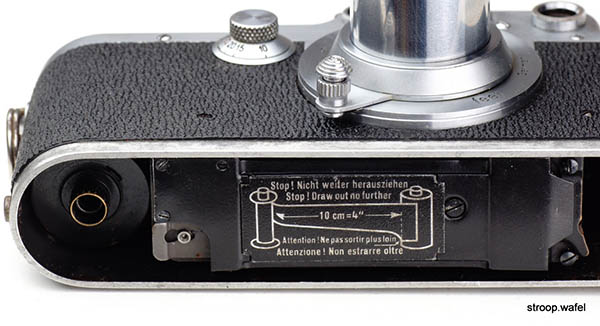
The screw-mount Leicas are bottom loading cameras and rather inconvenient to load as the film leader needs to be cut to slide properly over the sprocket wheels. Luckily Leica provided a little diagram at the bottom of the camera to remind people of this, a feature that other bottom loaders should perhaps have thought of (Iloca!).
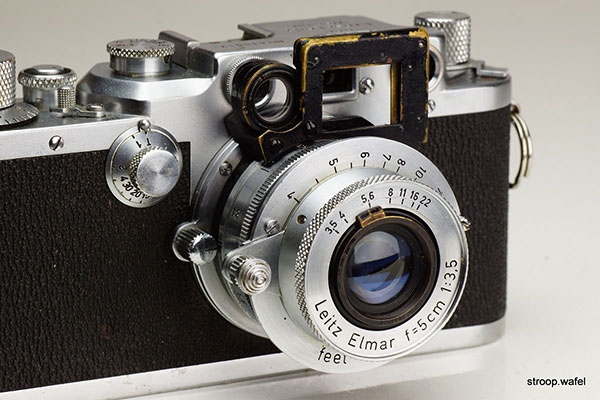
One of the fun but frustratingly expensive things about Leicas is that there are so many accessories available. Many had funny five-letter acronyms, this close-up attachment had the unfortunate name NOOKY. It screws on the lens mount and the collapsible Elmar is then inserted, its own focussing mount still attached. It allows near-macro photographs with a maximum enlargement of 1:6.5.
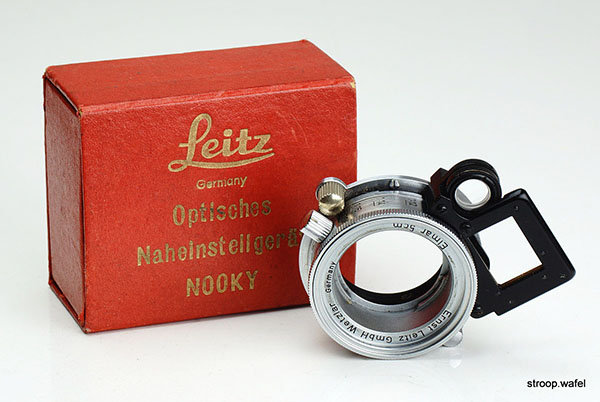
Here is a NOOKY close-up attachment with its original box. This one is for the Elmar, other versions were available for the Hektor, Summar and Summitar lenses (the NOOKY-HESUM) as well as the Summicron (the SOOKY).
The Leica IIIf was very similar to the Leica IIIc and the two were in fact hard to distinguish when viewed from the front. The main new features were a flash sync, which was located at the back of the camera next to the eye piece of the viewfinder, and a film reminder dial integrated in the wind knob. The speed dial was also slightly larger than the one on the IIIf and contained a synchro-dial to adjust the flash exposure settings.
Three different versions of the IIIf were produced in about equal numbers, the first had black synchro-dial numbers (hence called 'black dial' or BD), the second version had red numbers (i.e., red dial or RD), whereas the last version added a selftimer to the slow speed dial (hence RD ST).
The flash settings were a little idiosyncratic to say the least, but the system was designed to make high-speed flash synchronisation up to 1/1000th of a second possible. Some sources on the internet claim that the flash only worked at 1/30s, but that is only true when using electronic flash. Of course not many people use flash bulbs these days, so these sites have a point, but with the right flash bulbs high-speed synchronisation was possible.
The synchro-dial setting was dependent on the shutter speed with higher values for slower shutter speeds. The values were provided as a table which also listed the effective guide number from which the aperture setting could be calculated.
(Top) Rear view of a 1951 Leica IIIf BD showing the flash sync next to the viewfinder eye piece and the flash synchro dial beneath the speed dial. The black numbers of the synchro dial indentify this IIIf as a 'Black Dial'. Leitz provided a special flash sync plug (shown in the image) which would not poke into your eye when using the viewfinder.
(Bottom left) Detail showing the film reminder dial integrated with the wind knob. (Bottom right) The lens mounted on the camera is a red scale Elmar f/3.5, the last Elmar f/3.5 of the many incarnations produced by Leica. Earlier Elmars had the focus scale on the bottom ring and DOF scale on the barrel, so the other way around compared to the red scale Elmars.
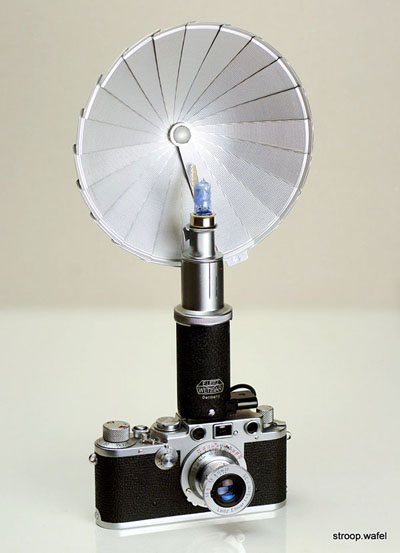 | |
Leica IIIf with the rather large, dedicated Leica flash unit 'Synchronblitzer' a.k.a. CEYOO, which fitted onto the camera's accessory shoe. |
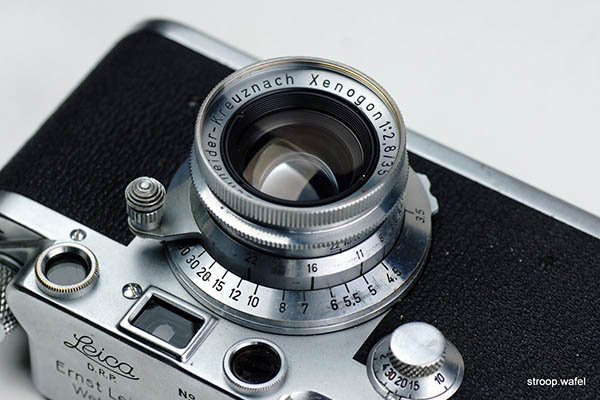
A rather uncommon wide angle lens in Leica screw mount was the Schneider Kreuznach Xenogon 35mm f/2.8. It was introduced around 1952 at a time when the fastest Leitz 35mm lens was the f/3.5 Summaron. It was presumably intended to compete with similarly fast Canon Serenar and Nikon W-Nikkor 35mm lenses. Leitz did not introduce a f/2.8 35mm lens until 1958.
Based on the serial numbers the Xenogon was produced until about 1957. As the serial numbers cluster strongly it appears they were made in small batches of a few 100 at a time, in total probably less than 2000 were made, most of them in 1952 and 1953.
The name Xenogon was probably derived from Xenon, as it had a similar optical formula of 6 elements in 4 groups in a symmetrical configuration, just like the Seranars, W-Nikkors and Summarons of the time. Note that this lens was different from the more common Xenagon, which was a 4-element lens derived from the Xenar, and as far as I am aware not available in Leica screw mount.
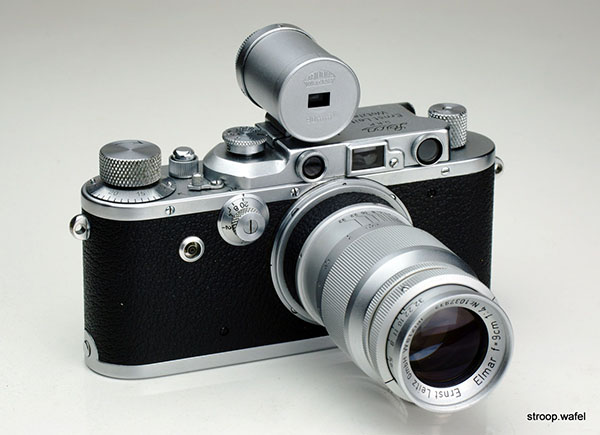
No Leica collection is complete without one of the telelenses. The 90mm f/4 Elmar had the best reputation, at least in the screwmount. This is a simple lens to clean and maintain; the front part of the lens simply unscrews from the focussing tube to provide easy access to the lens elements.
By lack of the proper Leitz 90mm viewfinder I mounted one from a neighbouring company in Wetzlar, Leidolf.
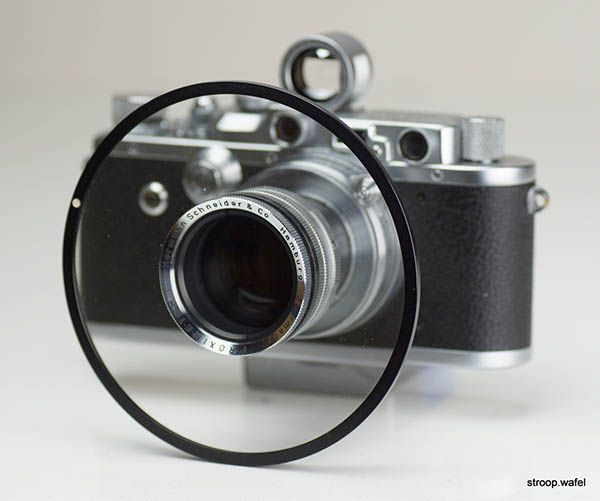
A rather unusual accessory for the Leica was the Proximeter. Proximeters were available for many cameras and usually included a close-up lens to mount on the camera lens as well an additional lens in front of the rangefinder which would compensate for distance and parallax. This particular one was a large round disc that contained both lenses. I actually had no idea these were made for Leica also, as there already was the NOOKY range of close-up attachments. I had seen one of these large round ones on a King Regula, so expected it to fit to Cassar lenses. However, it did not fit any of my cameras until I, mostly out of desperation, finally tried it on the Summitar. It fitted! Then I noticed in the included instructions that Leica was indeed listed. I have not yet tried how well it works. Advantage compared to the NOOKY is that one does not need to remove and remount the lens, potential drawback is that the close-up lens may degrade image quality.
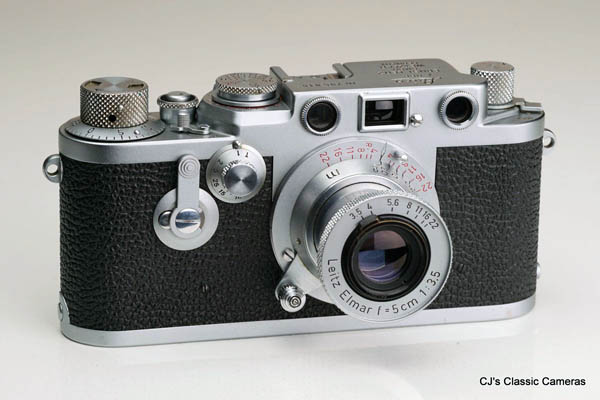
To finish this Leica screw mount section, I finally got my hands on what is my favourite Leica in terms of looks and design: a Leica IIIf with selftimer and matching red scale Elmar. This was the final incarnation of the screw-thread Leica before the Leica M3 was introduced; the Leica IIIg was actually introduced later and has a few useful improvements, but I don't think it looks as good as the IIIf RDST.
Fed-1 G
In the 1930s FED was the first company (or rather labour commune) to produce a 35 mm camera in Communist Russia. They chose their example (the Leica I!) wisely, although admittedly at that time the choice was limited. Initially based on the Leica I and II, the FED range slowly evolved into a range of increasingly different cameras. It became a hugely popular range with many million cameras produced. Many subtypes of each model existed, so a bewildering range of these cameras was available.
The first type, simply designated FED but now called Fed-1 to distinguish from later models, kept its clear Leica II heritage until the last version, the 1953 Fed-1 G. Enterprising individuals have used this similarity to convert FEDs to fake Leicas, but these are usually easy to spot due to several small design differences. That said, early FEDs may fetch prices comparable to Leicas in their own right.
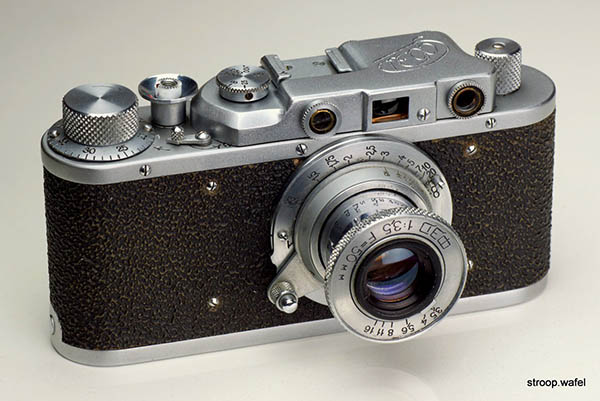
A 1956 Fed-1 G (#561825) with collapsible Fed 50/3.5 lens, the latter clearly a copy of the Leitz Elmar although the optical formula was different and more similar to a Tessar design. The 'G' was the last Fed-1 model, the following Fed-2 no longer looked like the original Leica II although it would still take the same 39mm screwmount lenses.
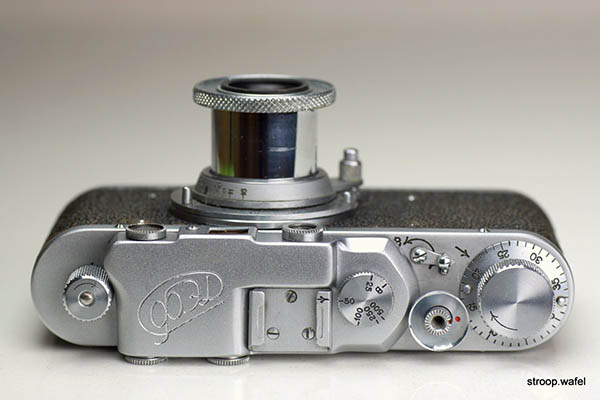
Top view of the same camera. Compare this with the same view of the Leica IIIc above and try to spot the differences! One give-away is the collar around the shutter release, which on the FED rotates during winding the shutter.
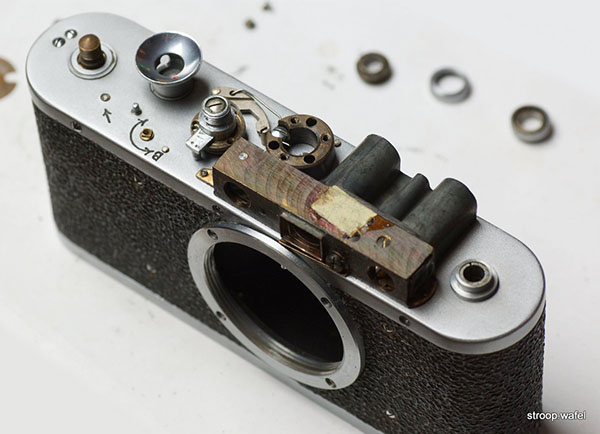
Opening up a FED seemed more sensible than doing the same to a working Leica...
KMZ Zorki Ic
The other Russian Leica copy one may come across is the Zorki. These were produced after the war, mainly for export. The first model again appeared to be based on the Leica II, but in fact it was a copy of the original FED. The FED factory had been destroyed during WWII and was having trouble getting production started after the war had finished. Therefore, production was moved to a different factory called KMZ in Moscow (known from the Moskwa folding cameras), the early model was called Fed-Zorki. From 1949 the two brands separated and produced their own camera ranges. Zorkis were mainly produced for export to the West, and later models diverged more and more from the original Leica heritage (see Zorki 4K below).
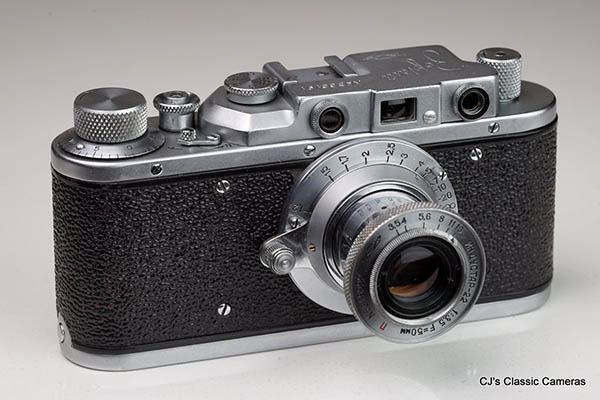
A 1951 Zorki Ic (model PM1075 according sovjetcams.com) with the last version of the collapsible Industar 50/3.5 lens from 1955, so probably not the original lens. Note the shiny screws on the front of the body, one of the features by which to distinguish these from actual Leicas. The name of this camera is written in Cyrillic script (Зоркий), so not yet meant for export.
Unsurprisingly, the first Zorkis were hard to distinguish from the Leica II, and even more so from the Fed-I. The model went through many small incremental changes (see the fabulous site www.sovietcams.com for all the details) and was produced until 1956, when it was replaced by the Zorki-C, which had a larger top housing, which is where the divergence from Leica-style cameras began.
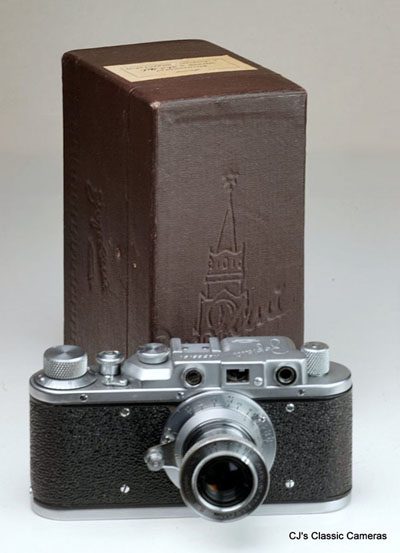
| |
Zorkis were commonly equipped with Industar lenses. These were generally also made in the KMZ factories and although originally almost cosmetically identical to the collapsible Elmar (including the awkward aperture adjustment), the optical formula was in fact that of a Tessar. Around 1949 a new aperture ring design was introduced, and this model stayed in production until 1957, slowly being replaced by rigid mount lenses in the later years.
The same Zorki Ic with its original box. The clock tower on the box depicts the Spasskya Tower of the Kremlin, an important cultural symbol in Moscow, where the Zorki originated.
|
Fed-4
The Fed-4 was the first Fed camera with a built-in selenium light meter. Fed was rather late to do so; when the Fed-4 was introduced in 1964, German cameras had these light meters for about 10 years and in fact, selenium cells already started to be phased out in favour of CdS cells on many Japanese cameras. Even then the light meter on the Fed-4 was uncoupled, so settings had to be transferred manually to the shutter. On the other hand, Leica itself did not introduce metering until the M5 in the early 70s.
The first Fed-4 model looked a lot like the Fed-3, with a large chrome top housing and small rangefinder windows. Its most peculiar feature was the lack of rewind knob, which had made way for the light meter unit and was therefore replaced by a rewind wheel at the side of the camera. Had the wheel been larger like on the Ferrania Lince it would have been all right, but unfortunately it was cumbersome to use. Around 1969 the Fed-4 was updated with a more modern-looking viewfinder frame and a wind lever, although the rewind wheel stayed. Despite the niggles it was a well-functioning and successful camera with a long production run of about 15 years and over 1 million units being build.
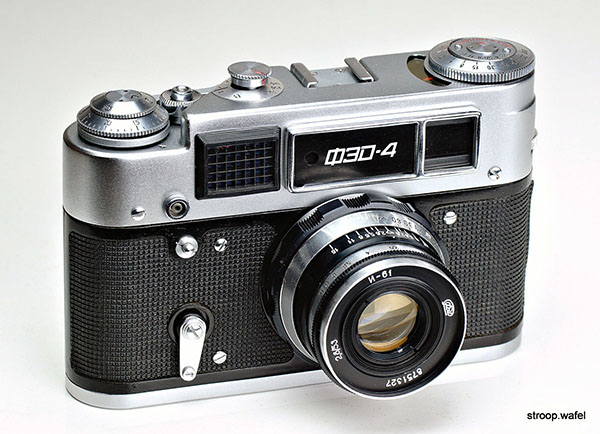
Late version of the Fed-4 with amber-coated Industar-61 53mm f/2.8 lens. All Fed-4 had this model lens but quite a few different versions existed, with various focal lengths (52mm, 53mm and 55mm) and body types (chrome, zebra chrome and black, or mostly black). Later versions had the suffix L/D (in cyrillic), the L apparently referring to lanthanum, a heavy element added to glass to increase its refractive index while keeping dispersion low.
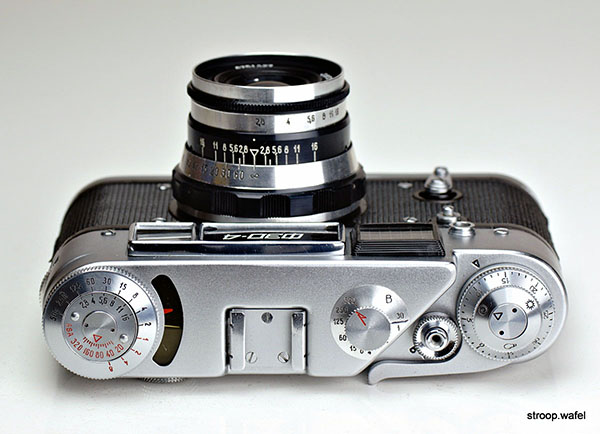
Top view of a Fed-4 showing the peculiar slanted edge of the op housing to make room for the wind lever. Note the simple uncoupled light meter on the left. Also note the range peculiar order of shutter speeds, with 1/30 in-between B and 1s. Like most Russian 'Leica copies', the shutter speed of this model can only be set after cocking the shutter and one should also not move the shutter speed dial from 1/30 to 1/s or vice versa, I drew a small line as a reminder.
Zorki 4K
The Zorki 4K, first produced in 1972, was the first model with rapid wind lever and looked little like a Leica copy anymore. It came with flash sync, time delay and large viewfinder window. About half a million of these were made. Somewhat ironically, at a time when the SLR camera had made the rangefinder system camera nearly obsolete in the West, Soviet copies like the FED, Zorki and Kiev kept the tradition alive.
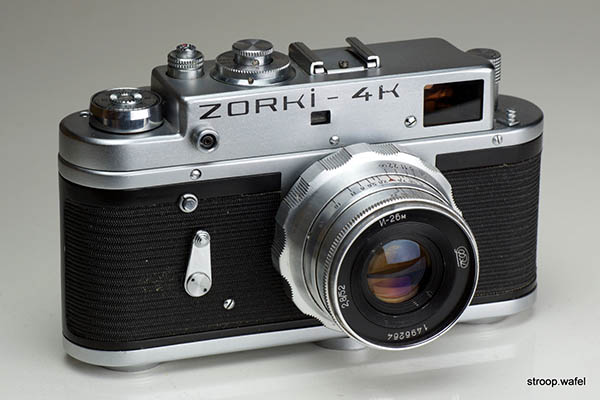
A Zorki 4K, which normally came with Jupiter 50mm f/2 lens but here with an older FED-branded Industar 26M lens. One drawback of most Russian Leica copies was that the shutter speed dial should only be set after the shutter was cocked, failure to do so could jam the shutter mechanism.
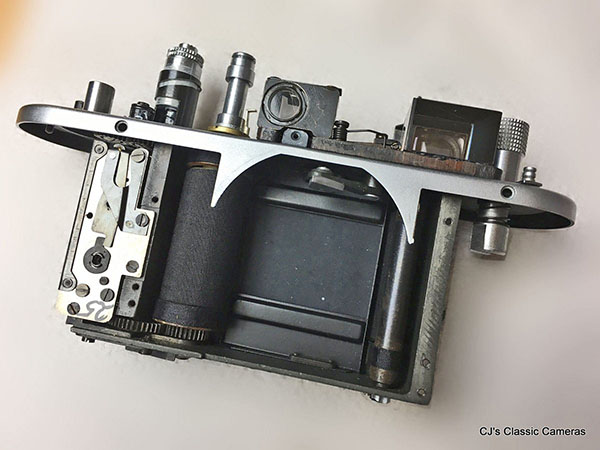
A Zorki 4K with top and front removed to provide access to rangefinder and shutter mechanism.
GOMZ Leningrad
A lesser known Russian Leica copy was the 1956 GOMZ Leningrad, although calling it a Leica copy does not do it justice. It had little more in common with the original Leicas than the screw mount, and in contrast to Fed and Zorki cameras the Leningrad was designed from the ground up. Its most distinguishing feature was the spring motor, which allowed taking many photos in rapid succession. It was very well-build but expensive and heavy camera that won in fact a reward at the 1958 World Exhibition in Brussels. It was only produced in (for Russian standards) small numbers (<100,000).
Despite its new design the camera did have some features reminiscent of other cameras. It feels more like a Kiev (Contax copy) than other Russian Leica copies and in fact the bottom plate is very similar to Kiev ones. In addition, the large spring motor wind knob and speed selector are reminiscent of the Finetta 99. Also the spring motor release for rewinding film at the bottom of the camera is the same as on the Finetta. Whatever its inspiration, the Leningrad designers took this camera much further and is probably the most impressive camera to come out of the former USSR.
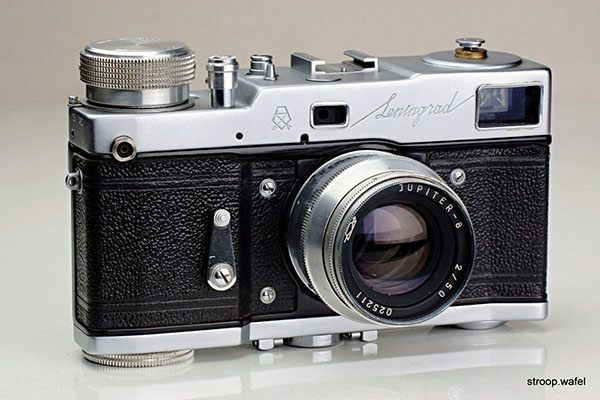
A GOMZ Leningrad with Jupiter 50mm f/2 lens. This example was an export model as the name Leningrad is written in Roman script, not Cyrillic. It is missing the rewind knob as well as the speed dial, which I to my shame only noticed after buying the camera.
Canon S-II
Canon will need little introduction as it is still the largest camera maker in the world. The company was founded in the 1930 under the name Precision Optical Instruments Laboratory (POIL), its first product being the Hansa Canon, a high-quality rangefinder largely based on the Leica II with some modifications. Interestingly, POIL lacked the expertise for making optics and therefore obtained the support from Nippon Kogaku, a company that later would turn into Nikon, Canon's largest competitor. So the first Canons had Nikkor lenses. More Canon models were soon to follow and eventually Canon started designing its own lenses, initially branded 'Serenar'.
After WWII Canon grew rapidly as a company and introduced several new rangefinder models in the early 1950s, all of which used the Leica screw mount. However, soon after the company would move increasingly towards making SLR cameras, apparently after the introduction of the Leica M3 and realising that it would take too much effort to keep up with rangefinder technology. That this was a wise decision needs little explanation, considering the dominance of Canon on the camera market ever since.
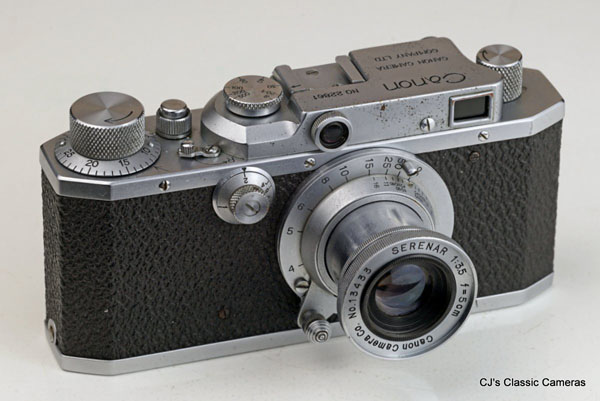
A Canon S-II from around 1947 with a collapsible Canon Serenar 50mm f/3.5 lens, giving it a more classic Leica look. Clearly based on the Leitz Elmar, the Serenar lens is constructed somewhat differently, but does have the aperture directly behind the front element, which is typical of the Elmar design.
Around the time of WWII Canon still was a very small camera maker, but this was about to change with the model shown below, the Canon S-II. It was the first Canon rangefinder to have a combined viewfinder/rangefinder as well as Leica-style screw mount. In essence, it looked and handled much more like (and in some ways better) a Leica than the earlier Canon models. The Canon S-II was first introduced in 1946 and during its three years of production over 7,500 were made.
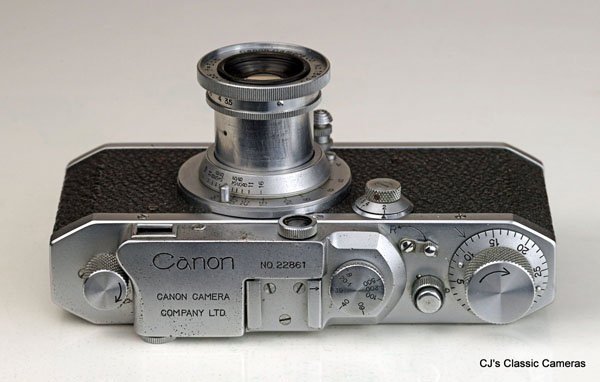
Top view of the Canon S-II showing the similarity to contemporary Leica models, although the corners are more angular and the viewfinder window is rectangular, not round. Also visible is the aperture ring of the Serenar lens, which is located behind the front ring, and a lot more convenient to operate than the aperture control notch at the front of a Leitz Elmar.
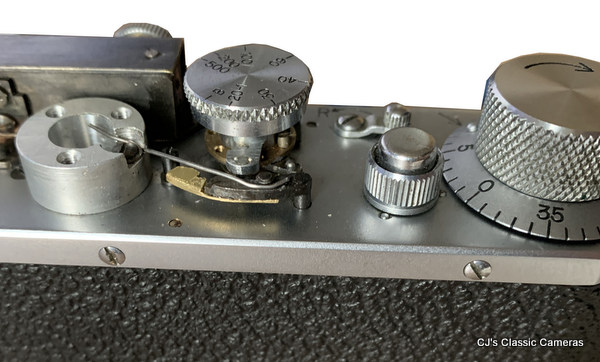
This example had a non-working shutter when it arrived, which is why I got it cheaply, but rather unusually it turned out it had a broken part: the shutter brake lever had broken off, not a fault I'd come across before. This lever isn't easily replaced, they're generally different for each model, and broken parts often mean that a donor camera is needed, but ni this case I thankfully managed to mend it by gluing a piece of brass that I had cut into the right shape to what was left of the original lever.
Canon II-F
Following the success of the S-II, Canon brought out a long list of models, often only slightly different from the previous one. The naming was also confusing, e.g. the popular IV-SB was introduced before the II-F shown below. If you want an excellent overview of all the models and their nuances, I recommend checking out the excellent https://www.canonrangefinder.org/ site.
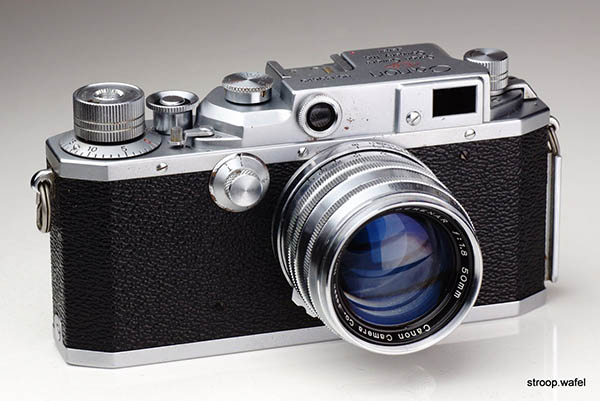
A Canon II-F from around 1953 with Canon Serenar 50mm f/1.8 lens. This lens had an optical design more similar to the Steinheil Xenon and the Zeiss Biotar than to the Leitz Summitar, but had an equally good reputation. I got a bargain on this one as it had a problem with one of its inner rear elements. It turned out to be a fine mist of oil droplets, which was easy to clean and now the lens is back up to its old tricks.
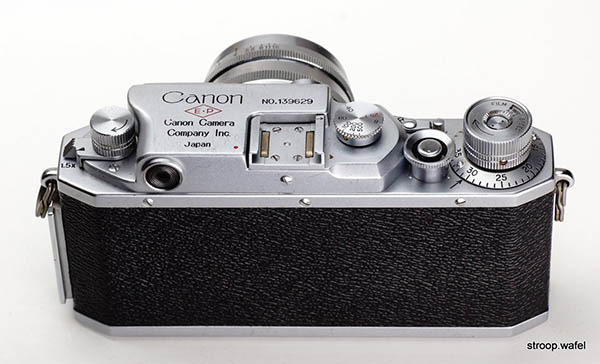
Top and rear view of the Canon II-F. Compared to screw-mount Leicas it benefited from having a single rangefinder/viewfinder window with adjustable magnification for ease of focussing, as well as a film reminder dial in the wind knob. It also featured a slow speed dial, a top shutter speed of 1/500s and a flash sync rail.
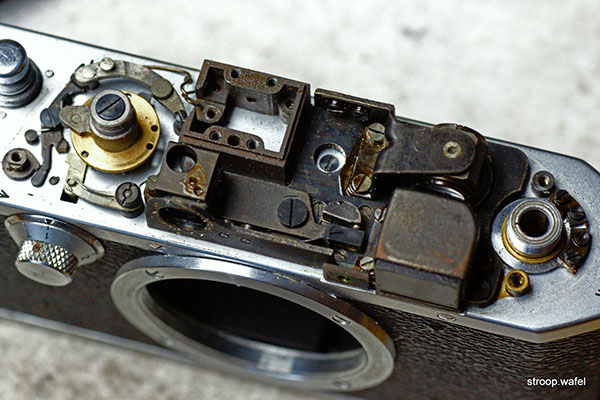
Canon IIF with top housing removed, showing speed dial (left) and rangefinder unit (right). The adjustable magnification of the rangefinder functioned by rotating the small lens unit near the eye piece by 90 or 180 degrees, respectively.
Stripping the camera this far to adjust the rangefinder would be unnecessary: the large screw next to the front viewfinder window hides a horizontal adjustment screw, whereas the vertical alignment could be adjusted by unscrewing the round cover ring of the rangefinder window and rotating the thus exposed glass element (not visible in this photo as it needed to be removed to disassemble the top housing).
Canon P
Although Canon decided after the introduction of the Leica M3 that they couldn't really follow suit and therefore shifted their focus to the development of SLR cameras, this did not mean that Canon stopped producing rangefinders. In fact, they brought out quite number of slightly different models with a confusing range of names. The 1959 Canon P was one of these. It was a simplified and thus cheaper version of the Canon VI L. The P missed the switchable optical viewfinder for use with wide angle lenses and to get rangefinder magnification. Canon introduced two more rangefinders after the P, the 7 and the 7S, which were equipped with build-in lightmeters.
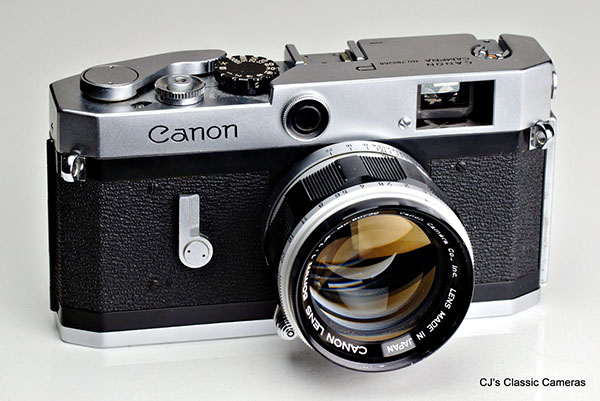
A Canon P with Canon 50mm f/1.4 lens, a wonderful piece of glass developed from the Serenar f/1.8 described above with the Canon II-F, having a similar optical design with 6 elements in 4 groups.
Showa Leotax
Besides Canon, the most well-known Japanese camera company that started out making Leica copies, there were several others such as Nicca, Chiyoda, Tanack and Leotax, whilst Yashica also produced a few models (after they took over Nicca). The company making the Leotax was Showa Optical Works, which was founded around 1938. They initially produced a Leica copy with an uncoupled rangefinder and also several folding cameras, as well as the Gemflex, an unusual subminiature TLR camera that's popular with collectors and therefore nowadays possibly the most well-known Leotax camera. The uncouped rangefinder version is very rare but easily recognisable as it has a round distance dial on top of its rangefinder housing. Showa gradually improved their Leica copies and in 1954 they introduced a proper Leica IIIf copy, changing their company name to Leotax Camera Co soon after. They produced several more rangefinder models but in the end they could not compete with Canon and Nikon, and went bankrupt by the end of that decade.
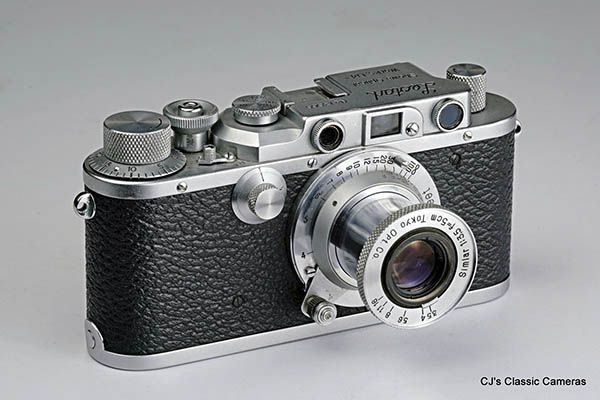
A Leotax D - IV with matching Simlar 50/3.5 lens. The build and quality of the engravings are impressive, and it would find it difficult to tell it apart from an original Leica if it didn't have the name printed on it. There are some small differences, for instance the rangefinder window has no focus lever like the early Leica III models, and it has a flared protector around the shutter release button - which itself has a screw-in remote release socket, also unlike Leicas.
Quite a few Leotax models exist and the naming isn't easy to figure out, but I believe mine is Leotax Model D IV from 1951. This was the first copy of a similar build standard to the original Leica, and it looks nearly identical to pre-WWII Leica III models. It had no flash sync, which subsequently appeared in 1952 on the Leotax S, whilst the 1954 Leotax F was essentially a copy of the Leica IIIf (itself introduced in 1950).
The lenses on the Leotax were called Simlar lenses and were made by a different company, the Tokyo Optical Co. (as indicated on the lens), which also made Topcor lenses. The name Simlar seemed to be reserved exclusively for Leotax cameras, as I haven't seen them on any other brands. This lens is very much an Elmar copy, probably down to its optical formula (as opposed to e.g. Russian Elmar copies which are optically actually Tessars), and they even have the serial number engraved in the brass front ring.
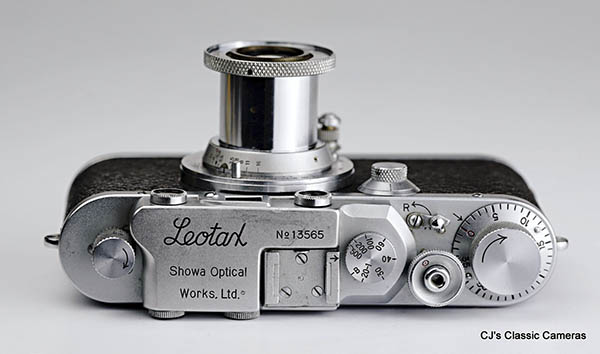
Top view of the Leotax. Somehow I keep thinking the engraving says Leotard instead.
Steinheil Casca
Although Steinheil München has a great reputation as a lens manufacturer, it is not very well known that for a short while the company also tried to gain ground as camera maker. In the late 1940s Steinheil produced two rather remarkable and unique cameras, the Casca I and Casca II. They were focal plane cameras, like Leicas, and perhaps this became the cameras downfall as the rumour goes that their production was halted due to infringements of Leitz patents. True or not, Leitz probably would not have cared so much if these cameras would not have been so far ahead of their time. Particularly the Casca II was a bit of a marvel, with a large brightline viewfinder with projected frame lines for telelenses and a unique bayonet lens mount with a range of lenses of four different focal lengths from 35 to 135 mm.
The Casca I pictured below was more conventional, although it did share its more advanced brother's unique look. However, it missed a rangefinder and slow shutter speeds and the lens bayonet was different so that lenses were not interchangeable between both Casca models.
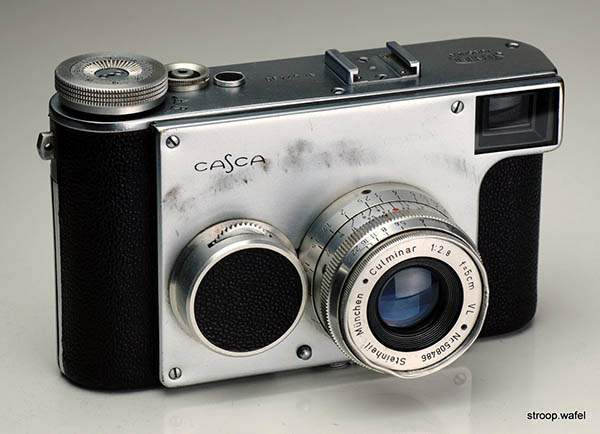
A Steinheil Casca with Culminar 5 cm f/2.8 lens. Perhaps not the prettiest camera but certainly unique. The lens was focussed by rotating the serrated wheel visible on top of the large black knob, but I don't really get the point as the lens was more easily focussed by turning the base of the lens itself. Also one tends to rub one's finder over the front plate, which is perhaps why many Casca's show wear marks there, including this one.
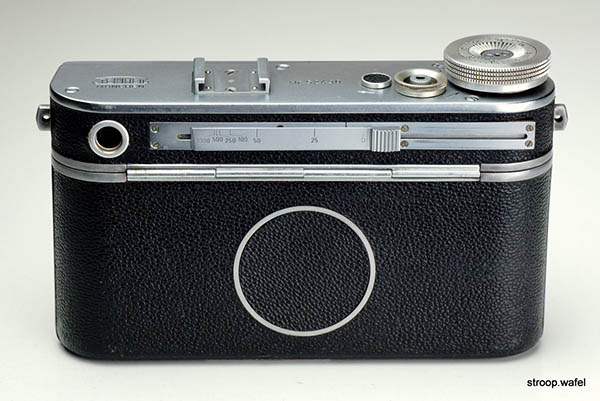
A Steinheil Casca from behind. Note the unique shutter speed selector in the form of a sliding lever at the rear of the top housing. The back of the camera would hinge upwards, making it easy to load film.
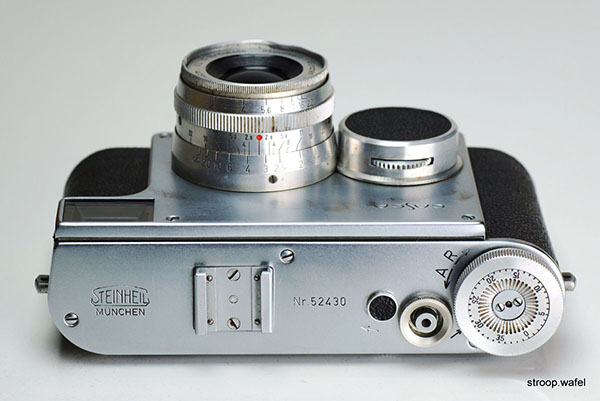
Top view of the Steinheil Casca. For those fooled into thinking this was a rollfilm camera due to the lack of a rewind knob, the wind knob also served as a rewind knob. The little black knob on top of the camera switches its function.
My Steinheil Casca came with a non-working shutter, so I made a (so far unsuccessful) attempt at fixing it. The photo on the left shows the body with metal coverings removed, I just re-attached the wind knob for testing the wind mechanism. Note the black paper covering most of the front, including the rangefinder windows for the Casca II.
Top right is the shutter mechanism, which apparently incurred the wrath of Leitz. Only one curtain moves in this example. Bottom right is a top view, which shows the reinforced base plate for the accessory shoe. Also note the viewfinder, just a simple Galilean type not unlike the ones on early folding Retinas and nothing like the one on the Casca II.
INA Navax
Another interesting but less advanced 'Leica copy' was the INA Navax. It was made ca. 1955 by a company which, rather unusually, started with building wooden hand carts (apparently in high demand just after WWII) and then started producing roller bearings. The company still exists. It only ever produced one camera, the Navax, although there is mention that Feinwerktechnik GmbH in Lahr, which made the Mec 16 submini camera, was a subsidiary from INA.
The Navax was a viewfinder camera with a metal focal plane shutter which moved vertically. It used 35mm film but the frame size was only 32x22mm, like the early Minolta 35 and Nikon rangefinders. It featured a wind lever and flash synchronisation, but was let down by its simple viewfinder. It came with a Roeschlein-Kreuznach Pointar 45mm f/2.8 lens, which was decent enough but not of Leica quality (and in fact designed for the Braun Paxette mount, see figure caption). All in all, the Navax was a well-build camera, but rather big and clumsy for its features. It is therefore no surprise that it was only produced in very small quantities.
An INA Navax with Roeschlein-Kreuznach Pointar 45mm f/2.8 lens. This was the standard lens for this camera, but somewhat ironically, it was a lens designed for the Braun Paxette mount (like the Leica, a 39mm screw thread but with a longer register distance) and was fitted onto the Navax by means of an adapter ring, which is visible at the base of the lens.
Leica M3
The Leica M3 was introduced in 1954 to replace the screwmount Leicas, which by then were based on a twenty-year old design. The new camera was revolutionary. It had a bayonet mount for rapid lens changing. It had frame lines for different focal lengths projected in the viewfinder. These frame lines were parallax corrected. The viewfinder was bright with a nearly 1:1 view and a very bright and sharp rangefinder patch. It had all shutter speeds available with a single speed dial. It had a windlever. It had a back that would flip open for easier film loading. And last but not least: it was fully compatible with screw-mount lenses. Some of the features had been introduced before, but the M3 was the complete package and build to an extremely high standard. This was at a time Kodak had just introduced their first rangefinder folding cameras, the IIc and IIIc, Canon still copied Leica III series cameras, and Nikon had barely evolved to models that could match the Contax it was based on. Interchangeable lenses needed additional viewfinders on the camera (as on the Diax range) or as accessories (like the Voigtlander Turnit for the Prominent).
The effect was near immediate. The M3 sold well. Other manufacturers introduced models with multiple framelines. Viewfinders were made larger and brighter. Canon introduced the VT in 1956 as their first rangefinder which no longer emulating the screwmount Leicas. Nikon introduced the superb SP in 1957. And Canon and Nikon started to invest in developing SLR cameras, which would soon take over the world. So perhaps the introduction of the Leica M3, the ultimate rangefinder, started or at least accelerated the demise of that very type of camera.
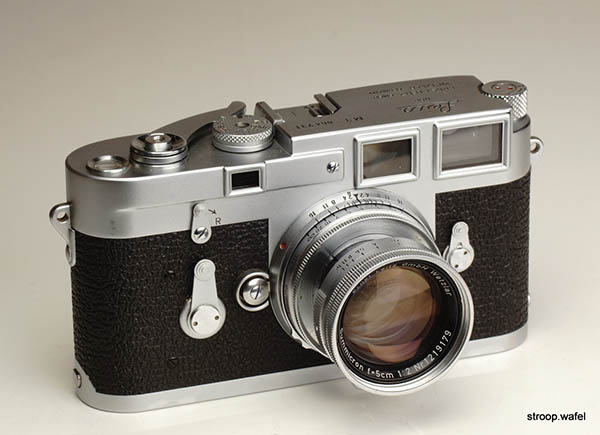
A Leica M3 with Summicron 50mm f/2 collapsible lens. This example from early 1957 is a double stroke model, later production had a single stroke windlever.
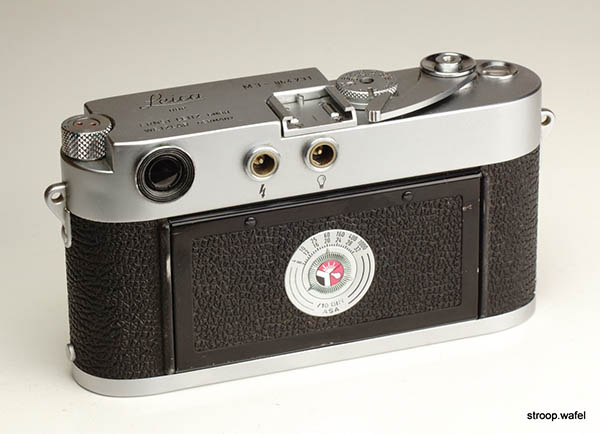
Rear view of a Leica M3, showing two flash connectors and the hinged camera back with film reminder dial.
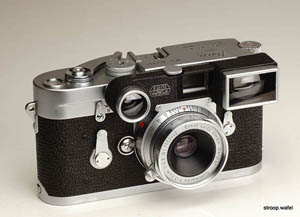
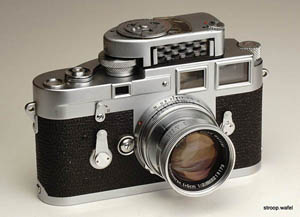
(left) The same Leica M3 with Summaron 35mm f/3.5 lens. As the viewfinder of the M3 had too large a view for 35mm frame lines to be fitted, a set of 'spectacles' was needed which would make the 50mm frame lines appear wider and adjust the focus of the rangefinder patch accordingly. The later M2 had a reduced viewfinder view and therefore a build-in 35mm frame. The spectacles can be removed from the lens by setting the focus to infinity and unscrewing the locking nut on top. A little ball hidden under the spectacles then serves as an infinity lock.
(right) A Leica M3 with Leitz MC meter (by Metrawatt). This light meter coupled to the speed dial, especially useful when working with fixed aperture.
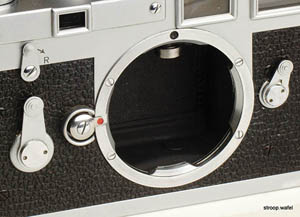
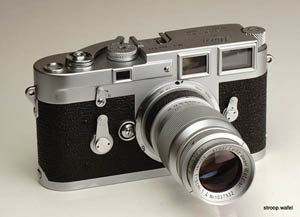
(left) Detail of the M3 bayonet lens mount. The lens was secured by the push button on the left. The lever on the left is the selftimer, the lever on the right determines which frames are visible in the viewfinder. In this position it shows the frame for the 90mm lens, when pushed to the left it shows the 135mm frame, in the middle it shows the 50mm frame only.
(right) Leica M3 with 90mm screwmount Elmar mounted. The M3 was fully backwards compatible with screwmount lenses, including rangefinder coupling, through an adapter ring. Different rings were available for different focal lengths, so that the proper frame lines would be projected. This system was continued with later Leica M models, which had more frame lines available than the M3.
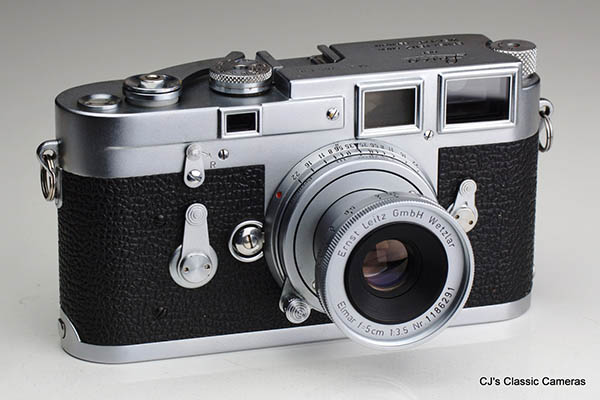
So here is another M3, this is a really early one from 1954 with a serial# in the 705,000 range, whilst the M3 production started with serial# 700,000 with a batch of 10,000 cameras, including this one. The lens is a fairly rare Elmar f/3.5, I didn't even realise this existed in M mount as I had only seen the f/2.8 version. However, the latter was only introduced in 1957, so it makes sense early M3s came with an f/3.5 Elmar. Early M3s did not have the frame line preview lever, whereas it is present on this example and must be a later update.
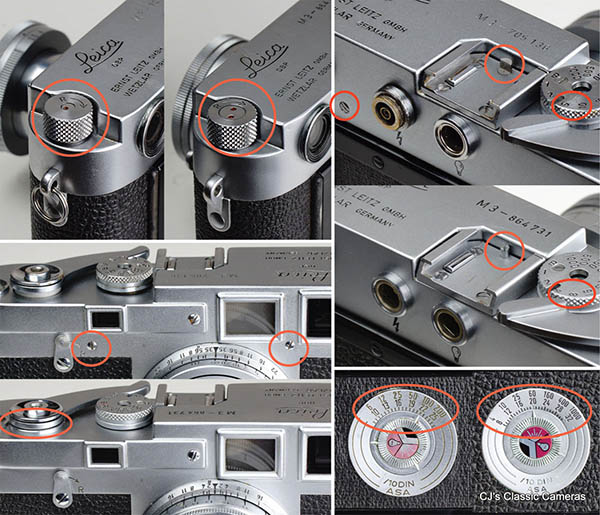
Upon comparing this M3 with the other one above there are quite a few small differences. some documented, some not. I've marked them in the above picture, with the earlier model to the left or at the top of the comparison pictures. The top plate screws disappeared on serial# 728,000, whereas the new shutter speed sequence was introduced on serial# 854,000. Note that the cover material on the back plate on the earlier example (right side bottom right photo) is non-original. Also note the backdoor is slightly smaller on the earlier model.
Nikon S2
The Nikon S2 was introduced in 1955, two years after the Leica M3 and therefore a little too late perhaps. Nevertheless, it was a great and attractive-looking camera that still has a great reputation. It had a 1:1 viewfinder that was nearly as good as the SBOOI Leitz accessory viewfinder, but not quite as good as the one on the Leica M3. It also had a lever wind as well as a lever rewind, much more convenient than the wind knobs on earlier models. Finally, it had a removable back for easy film loading.
What remained compared to earlier Nikons was the camera design itself, which was heavily based on the Zeiss Contax II with a bit of Leica thrown in. This particularly applied to the lens focus design, which was identical to the Contax, with the focussing helicoid built into the camera body. Hence, the standard lenses have no focussing mechanism. Wide and telelenses were mounted on a larger bayonet mount, again similar to the Contax range. The lenses are therefore in principle interchangeable, although there are reports that the focussing helicoid for the standard lens is slightly different, leading to incompatibility problems for fast lenses at close range. In contrast to the Contax the Nikon S2 had a horizontally travelling cloth shutter, similar to the Leicas, and therefore the dials on top of the camera are more Leica than Contax too.
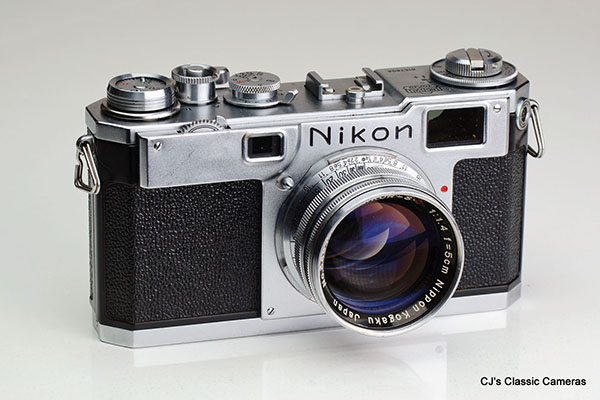
The very handsome Nikon S2, here with Nikkor-S.C 50mm f/1.4 lens. The lens was one of the few advantages Nikon had over Leica, who did not introduce a similarly fast lens until the 1960s.
Who thought Nikon gave up on rangefinders after the S2 would be mistaken, they continued to improve their design and introduced the Nikon SP only two years after the S2. At this moment Nikon had pretty much caught up with Leica and today an SP will fetch more than an M3 (as they are much harder to find). Note that the slightly later Nikon S3 and S4 were cheaper versions of the SP. After this Nikon introduced the F range SLR cameras and their success and ease of use essentially doomed any further development of rangefinder cameras.
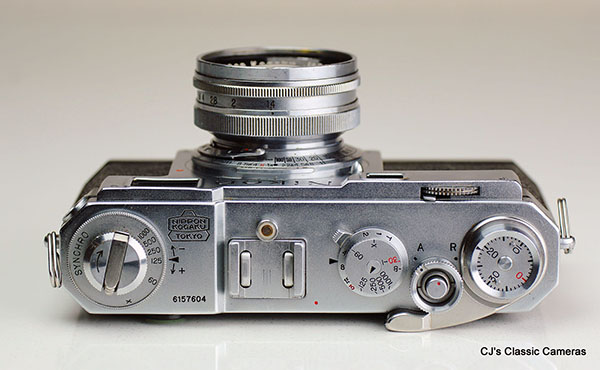
Top view of the Nikon S2. This example is an early version with chrome knobs, later production (the so-called 'black dial') had black knobs.
|

